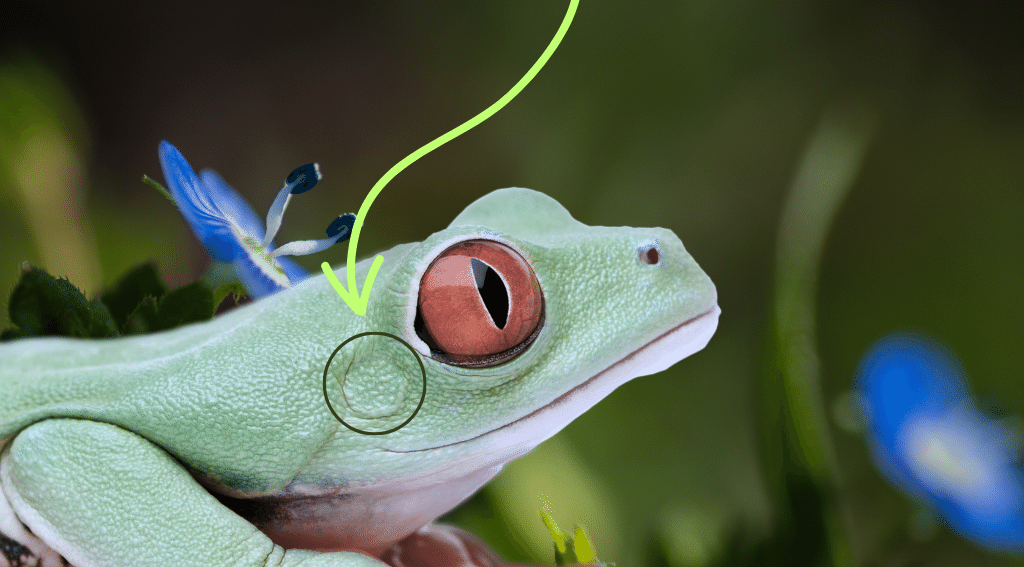do frogs have ears? If you look at a frog, you will notice that its ears look unusual. Do they have ears? How does their auditory system work? Join us at All Amphibian as we explore the auditory system of frogs.
Do frogs have ears?
At first glance, you might think that frogs don’t have ears. But frogs are not deaf and hear voices. Frogs have ears but their ears are different. frog’s ear seems strange because the ears of most animals normally consist of three parts: the inner ear, the middle ear, and the outer ear.
But frogs only have inner and middle ears and no outer ear. The reason why frog ears look strange is that they don’t have the structure of the outer ear. However, frogs have middle and inner ears and eardrums.
Frogs have a tympanum instead of an external ear. Tympanum is the circular part that is located behind the eyes of frogs. Tympanums are different according to the gender and race of frogs. Using this organ, frogs can hear sounds underwater and on land.
The tympanum is also responsible for preventing other substances from entering the frog’s ear. in fact, it only allows sound to enter the ear and prevents water and other substances from entering. Also, many species of frogs have an evolved hearing system.
Some frogs do not have a tympanic membrane and use other methods to hear sound. Usually, frogs that do not have a tympanic membrane hear with their lungs or mouth. Some other species can hear ultrasonic sounds and higher frequencies that humans and other animals cannot hear.

Why do frogs need to hear?
Hearing in frogs, like other animals, is one of the 5 senses they depend on for survival. They use hearing to move in different directions. Hearing is essential for the survival of frogs.
They use hearing to:
- Hearing the sounds of the opposite sex for mating.
- Identification and detection of predators.
- Find and track prey.
- Hear warnings when in danger.
- Establish communication with other frogs.
- Knowing the territory and range of other frogs.
- Balance and orientation to move.
Frogs have adapted their auditory system to their environment over millions of years to have a better chance of survival. Because frogs are amphibians and live both on land and in water, their hearing must be compatible with both environments.
How do frogs hear?

Hearing sound in us and many animals is done by receiving sound waves from the outer ear and earlobe. But it is not always like this. It is different in frogs.
Frogs have a complex hearing system. Frogs receive sound waves and vibrations through the tympanic membrane. The size of the tympanic membrane is different in frogs. You can tell the gender of the frog by the size of the tympanic membrane because it is larger in male frogs than in females.
This membrane can receive different frequencies. Then it transmits these waves through the inner and middle ear. in the frog, the tympanic membrane is connected to the lungs and the nervous system, and it transmits sound vibrations through them to the frog’s brain, where these sounds are processed.
Using these organs, the frog can recognize the frequency and direction of the sound. Because of their noisy living environment, frogs can distinguish sounds, which is called selective hearing.
What are the parts of a frog’s ear?

Generally, Frog ears have two parts: the middle ear and the inner ear.
This is how the middle ear and inner ear work:
Middle Ear :
The middle ear is the part that you can see on the frog’s head. It starts with the tympanic membrane. This part is just like the human eardrum. This membrane catches the infiltrations and transfers them to the inner ear. The function of the middle ear is to receive and transmitted sounds, not to process them.
Inner Ear :
The inner ear in frogs is a complex structure that consists of parts :
- Semicircular canals
- Papillary
- Macula
- Lagena
- Basilar papilla
- Sacculus
- Utricule
- and other parts
Low-frequency vibrations in different parts of the inner ear are amplified and converted to high frequency. Some parts of the inner ear have cells with fine hairs. Creating a sense of balance in frogs is also related to their inner ear, just like humans. The frog’s hearing system is also connected with other parts of its body such as its lungs and mouth.
Do frogs hear with their lungs?
Frogs cannot hear sounds with their lungs but the lungs of some frogs play an important role in their hearing system. since frogs live in noisy environments. They receive a lot of vibrations from their surroundings. Therefore, their lung can act as a sound absorber and remove the extra sounds around them.
For example, during the mating season, the female frog uses this method to distinguish the voice of the male frog from other sounds. By filling its lungs with air, the frog creates pressure behind the tympanic membrane, and this reduces other unnecessary vibrations and allows only the desired sound to pass.
Of course, this does not mean that the frog cannot hear other sounds. But by using his lungs, he only matches the desired sound. And in the case of mating, this will make the frog not waste its energy to find its mate and find it faster.
There is also a type of Panamanian frog that lacks the middle ear. But this frog hears sounds with its inner ear. The lungs of this frog are very close to the surface of its skin.
It has a thin skin that acts like a tympanic membrane and receives vibrations.
Then the lungs of this frog transmit the received sound waves to the inner ear, and in this particular species, the lungs play the role of the middle ear and are part of the frog’s hearing system.
Do frogs hear with their mouth?
Frogs do not hear sounds with their mouths, but their mouths are part of their hearing system. Their auditory structure is connected to their mouth. Frogs use their mouths to hear sounds better.
Some frogs are very small and do not have a tympanic membrane, or their tympanic membrane is not able to receive sound waves due to their small size. So they use their mouths to receive sound vibrations.
Gardiner’s frog is also a type of frog that uses its mouth as a middle ear to increase the frequency and transmit sound due to the lack of a middle ear and tympanic membrane.
Also, a part of the inner ear of frogs, which is tube-shaped and controls the amount of pressure in their middle ear when swimming, is inside the mouth of frogs. Frogs use this pressure to direct the sound, and usually, the pressure is higher on the side where the sound comes from.
How good are frogs hearing?

Frogs have very good hearing. They can hear sounds even better than humans and have a sophisticated hearing system. Perhaps this is because they need their sense of hearing to survive.
Frogs use their hearing well in sensitive situations such as helping their fellows, finding out about the existence of danger, determining the position and location of prey when mating to find the opposite sex, and such cases.
Frogs can usually hear sounds below 12 kHz. Their hearing is so good that some species of frogs can hear ultrasonic sounds and can hear sounds up to 38 kHz. These sounds are inaudible not only to humans but also to most animals.
Frogs can understand the sounds around them and adapt their behavior to the environment. For example, during the mating season, each male frog sings in his own time and turns, and you will never see two frogs singing at the same time.
Also, in urban areas and around noisy roads, frogs do not sing during busy and noisy hours because they know that it is much harder for the female frog to recognize their voice at that time.
Some species of frogs are very sensitive to sound vibrations. Like a kind of African frog that if exposed to too much noise in the water leads to vomiting and in some cases even death.
Conclusion
Frogs can hear sounds, but frogs ears look different from humans and many other animals. This is because frogs do not have external ears. They have two circular membranes called tympans on their heads just behind their eyes.
This membrane acts like the human eardrum and receives sound vibrations. Also, the tympanic membrane does not allow the entry of water and other substances except sound. Hearing is essential for the survival of frogs.
In the wild, frogs need hearing for things like knowing about danger, identifying and locating prey, and mating. Lungs and mouth also play a very important role in the hearing of frogs.
Some species of frogs that do not have a tympanic membrane receive sound vibrations with their lungs or mouth. Frogs have a powerful hearing system and can hear the sounds around them very well. They also can adapt their behavior to the sounds around them.
FAQ
-
- Do frogs have ears?
Yes, frogs also have ears, but because they don’t have external ears, their ears look different from humans and many other animals.
-
- How do frogs hear?
Frogs have two circular membranes called tympans on both sides of their heads and just behind their eyes. This membrane receives sound vibrations like the human eardrum.
-
- what are the parts of a frog’s ear?
The frog ear has two parts called the middle ear and the inner ear. The middle ear is responsible for receiving and transmitting vibrations, and the inner ear transmits vibrations to the brain through the nervous system.
-
- why do frogs need to hear?
Hearing is essential for the survival of frogs. They use their hearing for locomotion and balance, danger awareness, prey identification, and location, as well as finding the opposite sex during mating.
-
- Do frogs hear with their lungs?
Frogs cannot hear sound with their lungs, but their lungs play an important role in their hearing system. Their lungs amplify the sound, and in some species, due to the lack of a tympanic membrane, the lungs perform the task of receiving and transmitting sound like the middle ear.
-
- Do frogs hear with their mouths?
In general, frogs cannot hear with their mouths, but their mouths are part of the frog’s vocal system. Some smaller species of frogs, which do not have a tympanic membrane due to their small size, use their mouths to receive sound.
-
- How good is frog hearing?
Frogs have powerful hearing and because of their complex hearing system, they can even hear better than humans.

